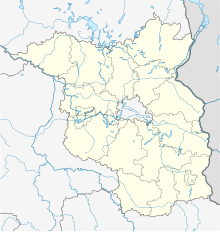Desert mark
Coordinates: 52 ° 22 ′ 52 " N , 13 ° 9 ′ 45" E
The Mark desert is a 21.83 hectare arable area in the Parforceheide in Brandenburg and belongs to the Stahnsdorf community . Until 1988 it was an exclave of West Berlin in the GDR .
Naming
The name refers to a desert , i.e. to an abandoned settlement. The naming of Gerhard Strasse in Zehlendorf was made with reference to a place Gerhard village, located in the Middle Ages to have been here. However, other sources report from a Gerhardsdorf in Wüstemark (today: Zeuthen ), so that - if there were no identical names - there could be a mix-up in one of the two cases.
history
The Mark desert came into Berlin possession in 1915 through purchase with the so-called " permanent forest contract " and was administered as an exclave to the community of Wannsee . In 1920 this became part of the Berlin district of Zehlendorf by means of the Greater Berlin Act .
The Mark desert acquired particular importance with the division of Germany , when it belonged to West Berlin as an exclave within the GDR until an exchange of territory in 1988. In contrast to the neighboring Steinstücke exclave , the Mark desert was uninhabited and not fenced in or surrounded by the Berlin Wall . Only border area signs marked it as a prohibited area.
In 1959, the area was leased by the Zehlendorf farmer and genealogist Hans Erich Wendt (born August 22, 1915 in Wallmow ; † February 27, 1988 in Potsdam ). After the Wall was built in 1961, this was initially over until the farmer was granted access to his field again in 1965 by the GDR government. He received a special pass from the GDR authorities and was allowed to drive his tractor over the Dreilinden border crossing on the transit motorway to his field. Since the area swap in 1988, when West Berlin received the Lenné triangle , the area has belonged to Stahnsdorf . This exchange took place without Wendt's knowledge, who died a short time later of a heart attack while staying in Potsdam .
Individual evidence
- ↑ Gerhardsdorfer Strasse. In: Street name lexicon of the Luisenstädtischer Bildungsverein (near Kaupert )
- ↑ A place with history . In: Berliner Zeitung , March 19, 1997; via Wüstemark (today: Zeuthen).
- ^ Correspondence sheet of the German Society for Anthropology, Ethnology and Prehistory (1915).
- ↑ Falk-Rüdiger Wünsch, Berlin-Zehlendorf, tell old pictures. Sutton-Verlag , 2001, p. 7.
- ↑ a b Christian Simon : Berlin Grotesk. The wall in the absurd everyday life of a megacity. Christian Simon Verlag, Berlin 2011, ISBN 978-3-936242-14-0 , p. 57/58.
- ↑ a b Werner Heegewaldt: The Uckermärkische Archiv von Hans Wendt, a finding aid for the Wendt estate in the Brandenburgisches Landeshauptarchiv (= series of publications of the Stoye Foundation, Volume 44), Marburg an der Lahn 2007, online
- ↑ Hope for pieces of stone . In: Die Zeit , No. 45/1971.
- ↑ a b Honecker ring twice . In: Der Spiegel . No. 13 , 1988, pp. 89 f ( online ).


